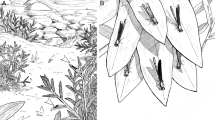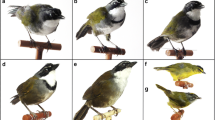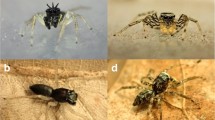Abstract
Sexual selection via male competition is a strong evolutionary force that can drive rapid changes in competitive traits and subsequently lead to population divergence and speciation. Territorial males of many odonates are known to use their colorful wings as visual signals and to perform agonistic displays toward intruders. Psolodesmus mandarinus dorothea and Psolodesmus mandarinus mandarinus are two parapatrically distributed sister damselflies that share similar ecological characteristics but differ markedly in wing coloration. The wings of P. m. dorothea are mostly clear, whereas those of P. m. mandarinus have a large area of black pigmentation and a central white patch. We investigated whether territorial males of the two damselflies at breeding sites display distinct agonistic behaviors associated with their respective wing colors. Behavioral interactions between territorial and intruder males and their wing kinematics were filmed and analyzed for P. m. dorothea in Lienhuachih of central Taiwan, and P. m. mandarinus in Tianxiyuan and Fusan of northern Taiwan. We observed that the P. m. mandarinus males exhibited a novel set of perched wing displays, which was not only absent in its sister P. m. dorothea but also previously unknown in Odonata. At breeding sites, perched rival males of P. m. mandarinus with pigmented wings exhibited escalating agonistic wing-flapping and wing-hitting displays toward each other. In contrast, territorial males of P. m. dorothea with clear wings engaged only in aerial chase or face-to-face hovering when intruder males approached from the air. These results indicate that the two sister P. mandarinus damselflies diverged behaviorally in territorial contests and support the hypothesis of coadaptation on the basis of wing colors and types of wing movement in Odonata. Our findings further suggest that divergent agonistic wing displays may play a pivotal role in the speciation mechanism of P. mandarinus damselflies. The sequential analyses of behavioral characteristics and progression suggest that P. m. mandarinus damselflies likely use mutual assessment of rivals in territorial contests.







Similar content being viewed by others
Data and code availability
All data used in this study are available on Figshare: https://figshare.com/s/6be8e699b8d09097fda9; https://doi.org/10.6084/m9.figshare.16417926.
References
Anderson CN, Grether GF (2010) Interspecific aggression and character displacement of competitor recognition in Hetaerina damselflies. Proc R Soc London, B 277:549–555. https://doi.org/10.1098/rspb.2009.1371
Anderson RC, DuBois AL, Piech DK, Searcy WA, Nowicki S (2013) Male response to an aggressive visual signal, the wing wave display, in swamp sparrows. Behav Ecol Sociobiol 67(4):593–600. https://doi.org/10.1007/s00265-013-1478-9
Andersson M (1994) Sexual Selection. Princeton University Press, Princeton (NJ)
Andrew RJ (1961) The displays given by passerines in courtship and reproductive fighting: a review. Ibis 103(4):549–579. https://doi.org/10.1111/j.1474-919X.1961.tb02452.x
Arnott G, Elwood RW (2009) Assessment of fighting ability in animal contests. Anim Behav 77:991–1004. https://doi.org/10.1016/j.anbehav.2009.02.010
Benelli G (2014) Aggression in Tephritidae flies: where, when, why? Future directions for research in integrated pest management. Insects 6(1):38–53. https://doi.org/10.3390/insects6010038
Briffa M, Elwood RW (2009) Difficulties remain in distinguishing between mutual and self-assessment in animal contests. Anim Behav 77:759–762. https://doi.org/10.1016/j.anbehav.2008.11.010
Briffa M, Hardy ICW, Gammell MP, Jennings DJ, Clarke DD, Goubault M (2013) Analysis of animal contest data. In: Hardy ICW, Briffa M (eds) Animal contests. Cambridge University Press, Cambridge, UK, pp 47–85
Brydegaard M, Jansson S, Schulz M, Runemark A (2018) Can the narrow red bands of dragonflies be used to perceive wing interference patterns? Ecol Evol 8(11):5369–5384. https://doi.org/10.1002/ece3.4054
Caro T, Sherman PW (2012) Vanishing behaviors. Conserv Lett 5(3):159–166. https://doi.org/10.1111/j.1755-263X.2012.00224.x
Corbet P (1999) Dragonflies, behavior and ecology of Odonata. Cornell University Press, Ithaca, NY
Chen ZY, Hsu Y, Lin CP (2020) Allometry and fighting behaviour of a dimorphic stag beetle Cyclommatus mniszechi (Coleoptera: Lucanidae). Insects 11(2):81. https://doi.org/10.3390/insects11020081
Cordero-Rivera A (2017) Behavioral diversity (ethodiversity): a neglected level in the study of biodiversity. Front Ecol Evol 5:7. https://doi.org/10.3389/fevo.2017.00007
Cordero-Rivera A, Zhang HM (2018) Ethological uniqueness of a damselfly with no near relatives the relevance of behaviour as part of biodiversity. Anim Biodivers Conserv 41(1):161–174. https://doi.org/10.32800/abc.2018.41.0161
Córdoba-Aguilar A (Ed.) (2008). Dragonflies and damselflies: model organisms for ecological and evolutionary research. OUP Oxford
Córdoba-Aguilar A, Cordero-Rivera A (2005) Evolution and ecology of Calopterygidae (Zygoptera: Odonata): status of knowledge and research perspectives. Neotrop Entomol 34(6):861–879. https://doi.org/10.1590/S1519-566X2005000600001
Dijkstra PD, Border SE (2018) How does male-male competition generate negative frequency-dependent selection and disruptive selection during speciation? Curr Zool 64(1):89–99. https://doi.org/10.1093/cz/zox079
Enquist M, Leimar O, Ljungberg T, Mallner Y, Segerdahl N (1990) A test of the sequential assessment game: fighting in the cichlid fish Nannacara anomala. Anim Behav 40:1–14. https://doi.org/10.1016/s0003-3472(05)80660-8
Green PA, Patek SN (2018) Mutual assessment during ritualized fighting in mantis shrimp (Stomatopoda). Proc R Soc London, B 285:20172542. https://doi.org/10.1098/rspb.2017.2542
Grether GF, Anderson CN, Drury JP, Kirschel AN, Losin N, Okamoto K, Peiman KS (2013) The evolutionary consequences of interspecific aggression. Ann NY Acad Sci 1289:48–68. https://doi.org/10.1111/nyas.12082
Guillermo-Ferreira R, Bispo PC, Appel E, Kovalev A, Gorb SN (2015) Mechanism of the wing colouration in the dragonfly Zenithoptera lanei (Odonata: Libellulidae) and its role in intraspecific communication. J Insect Physiol 81:129–136. https://doi.org/10.1016/j.jinsphys.2015.07.010
Guillermo-Ferreira R, Gorb SN, Appel E, Kovalev A, Bispo PC (2015) Variable assessment of wing colouration in aerial contests of the red-winged damselfly Mnesarete pudica (Zygoptera, Calopterygidae). Sci Nat 102(3–4):13. https://doi.org/10.1007/s00114-015-1261-z
Guillermo-Ferreira R, Bispo PC, Appel E, Kovalev A, Gorb SN (2019) Structural coloration predicts the outcome of male contests in the Amazonian damselfly Chalcopteryx scintillans (Odonata: Polythoridae). Arthropod Struct Dev 53:100884. https://doi.org/10.1016/j.asd.2019.100884
Günther A, Hilfert-Rüppell D, Rüppell G (2014) Reproductive behaviour and the system of signalling in Neurobasis chinensis (Odonata, Calopterygidae) – a kinematic analysis. Int J Odonatol 17(1):31–52. https://doi.org/10.1080/13887890.2014.881305
Hawkes MF, Duffy E, Joag R, Skeats A, Radwan J, Wedell N, Sharma MD, Hosken DJ, Troscianko J (2019) Sexual selection drives the evolution of male wing interference patterns. Proc R Soc London, B 286:20182850. https://doi.org/10.1098/rspb.2018.2850
Hilfert-Rüppell D, Rüppell G (2013) Do coloured-winged damselflies and dragonflies have flight kinematics different from those with clear wings? Int J Odonat 16(2):119–134. https://doi.org/10.1080/13887890.2013.763332
Iyengar VK, Castle T, Mullen SP (2014) Sympatric sexual signal divergence among North American Calopteryx damselflies is correlated with increased intra- and interspecific male-male aggression. Behav Ecol Sociobiol 68:275–282. https://doi.org/10.1007/s00265-013-1642-2
Junior RSL, Peixoto PEC (2013) Males of the dragonfly Diastatops obscura fight according to predictions from game theory models. Anim Behav 85(3):663–669. https://doi.org/10.1016/j.anbehav.2012.12.033
Katayama N, Abbott JK, Kjærandsen J, Takahashi Y, Svensson EI (2014) Sexual selection on wing interference patterns in Drosophila melanogaster. Proc Natl Acad Sci USA 111(42):15144–15148. https://doi.org/10.1073/pnas.1407595111
Lackey A, Martin MD, Tinghitella RM (2018) Male competition and speciation: expanding our framework for speciation by sexual selection. Curr Zool 64(1):69–73. https://doi.org/10.1093/cz/zoy009
Lin S-C, Chen Y-F, Shieh S-H, Yang P-S (2014) A revision of the status of Psolodesmus mandarinus based on molecular and morphological evidence (Odonata: Calopterygidae). Odonatologica 43(1):51–66
Lin S-C, Chen Y-F, Shieh S-H, Yang P-S (2012) Patterns of mitochondrial and wing morphological differentiation in Taiwanese populations of Psolodesmus mandarinus McLachlan (Zygoptera: Calopterygidae). Odonatologica 41:109–121
Marden JH, Waage JK (1990) Escalated damselfly territorial contests are energetic wars of attrition. Anim Behav 39:954–959. https://doi.org/10.1016/S0003-3472(05)80960-1
McCullough EL, Tobalske BW, Emlen DJ (2014) Structural adaptations to diverse fighting styles in sexually selected weapons. Proc Natl Acad Sci USA 111:14484–14488. https://doi.org/10.1073/pnas.1409585111
Mikami OK, Kohda M, Kawata M (2004) A new hypothesis for species coexistence: male-male repulsion promotes coexistence of competing species. Popul Ecol 46:213–217. https://doi.org/10.1007/s10144-004-0189-5
Nixon MR, Orr AG, Vukusic P (2017) Covert linear polarization signatures from brilliant white two-dimensional disordered wing structures of the phoenix damselfly. J R S Interface 14(130):20170036. https://doi.org/10.1098/rsif.2017.0036
Orr AG, Nixon MR, Vukusic P (2017) The nature and structure of the white-reflecting underside ‘scales’ on the hind wing of Pseudolestes mirabilis (Odonata: Pseudolestidae). Odonatologica 46(1/2):83–97
Pajunen, V. I. (1966). Aggressive behaviour and territoriality in a population of Calopteryx virgo L. (Odonata: Calopterygidae). Ann Zool Fenn 3 201–214. http://www.jstor.org/stable/23731277
Parker GA (1974) Assessment strategy and evolution of fighting behavior. J Theor Biol 47:223–243. https://doi.org/10.1016/0022-5193(74)90111-8
Payne RJH (1998) Gradually escalating fights and displays: the cumulative assessment model. Anim Behav 56:651–662. https://doi.org/10.1006/anbe.1998.0835
Payne RJH, Pagel M (1996) Escalation and time costs in displays of endurance. J Theor Biol 183:185–193. https://doi.org/10.1006/jtbi.1996.0212
Payne RJH, Pagel M (1997) Why do animals repeat displays? Anim Behav 54:109–119. https://doi.org/10.1006/anbe.1996.0391
Plaistow SJ, Siva-Jothy MT (1996) Energetic constraints and male mate securing tactic in the damselfly Calopteryx splendens xanthostoma (Charpentier). Proc R Soc London, B 263:1233–1238. https://doi.org/10.1098/rspb.1996.0181
Schultz TD, Fincke OM (2009) Structural colours create a flashing cue for sexual recognition and male quality in a Neotropical giant damselfly. Funct Ecol 23:724–732. https://doi.org/10.1111/j.1365-2435.2009.01584.x
Seehausen O, Schluter D (2004) Male-male competition and nuptial-colour displacement as a diversifying force in Lake Victoria cichlid fishes. Proc R Soc London, B 271:1345–1353. https://doi.org/10.1098/rspb.2004.2737
Shevtsova E, Hansson C, Janzen DH, Kjærandsen J (2011) Stable structural color patterns displayed on transparent insect wings. Proc Natl Acad Sci USA 108(2):668–673. https://doi.org/10.1073/pnas.1017393108
Silsby J (2001) Dragonflies of the world. CSIRO Publishing, Collingwood, Australia
Suhonen J, Rantala MJ, Honkavaara J (2008) Territoriality in odonates. In: Córdoba-Aguilar A (ed) Dragonflies and damselflies: model organisms for ecological and evolutionary research. Oxford University Press, New York, pp 203–217
Svensson EI, Eroukhmanoff F, Friberg M (2006) Effects of natural and sexual selection on adaptive population divergence and premating isolation in a damselfly. Evolution 60:1242–1253. https://doi.org/10.1554/06-036.1
Svensson EI, Waller JT (2013) Ecology and sexual selection: evolution of wing pigmentation in calopterygid damselflies in relation to latitude, sexual dimorphism and speciation. Am Nat 182(5):E174-195. https://doi.org/10.1086/673206
Taylor PW, Elwood RW (2003) The mismeasure of animal contests. Anim Behav 65:1195–1202. https://doi.org/10.1006/anbe.2003.2169
Tinghitella RM, Lackey AC, Martin M, Dijkstra PD, Drury JP, Heathcote R, Keagy J, Scordato ES, Tyers AM (2018) On the role of male competition in speciation: a review and research agenda. Behav Ecol 29(4):783–797. https://doi.org/10.1093/beheco/arx151
Tsubaki Y, Hooper RE, Siva-Jothy MT (1997) Differences in adult and reproductive lifespan in the two male forms of Mnais pruinosa costalis Selys (Odonata: Calopterygidae). Res Popul Ecol 39:149–155. https://doi.org/10.1007/BF02765260
Wellenreuther M, Sánchez-Guillén RA (2016) Nonadaptive Radiation in Damselflies. Evol Appl 9(1):103–118. https://doi.org/10.1111/eva.12269
West-Eberhard MJ (1983) Sexual selection, social competition, and speciation. Q Rev Biol 58:155–183. https://doi.org/10.1086/413215
Xu M, Fincke OM (2015) Ultraviolet wing signal affects territorial contest outcome in a sexually dimorphic damselfly. Anim Behav 101:67–74. https://doi.org/10.1016/j.anbehav.2014.12.018
Acknowledgements
We thank members of C.-P.L.’s laboratory for their help with field work. J.W.M. was supported by an international internship of Taiwan International Graduate Program-International Internship Program (TIGP-IIP) of Academia Sinica. Taiwan Forestry Research Institution and Yangmingshan National Park issued research permits and provided logistic support. We thank two anonymous reviewers for comments on earlier versions of this manuscript.
Funding
The Ministry of Science and Technology of Taiwan (MOST 106–231-B-003–004-MY3 to C.-P.L.) and Yangmingshan National Park (YMSNP 1051004901 to L.S.B.) provided financial support.
Author information
Authors and Affiliations
Corresponding author
Additional information
Communicated by: Matthias Waltert
Publisher's note
Springer Nature remains neutral with regard to jurisdictional claims in published maps and institutional affiliations.
Rights and permissions
About this article
Cite this article
Batucan, L.S., Hsu, YH., Maliszewski, J.W. et al. Novel wing display and divergent agonistic behaviors of two incipient Psolodesmus damselflies. Sci Nat 108, 49 (2021). https://doi.org/10.1007/s00114-021-01758-6
Received:
Revised:
Accepted:
Published:
DOI: https://doi.org/10.1007/s00114-021-01758-6




